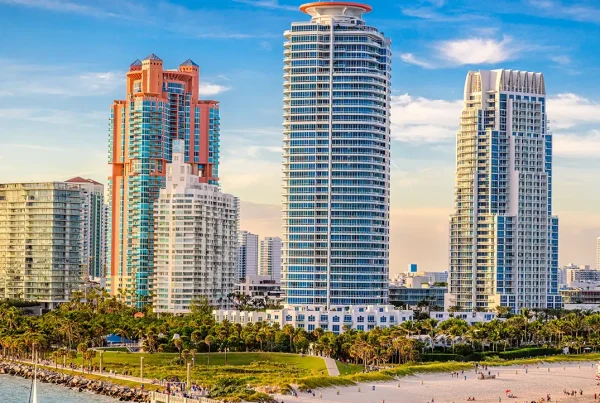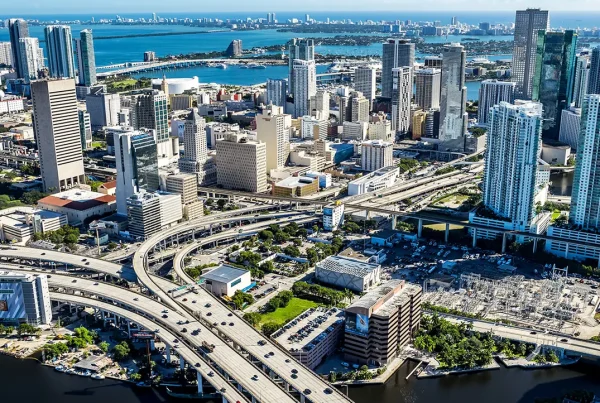Relocating to Miami? Whether you’re moving for work, lifestyle, retirement, or investment opportunities, Miami offers an unmatched combination of sunshine, culture, and global connectivity. But making the move requires planning. From choosing the right neighborhood and understanding the cost of living to navigating schools, healthcare, and transportation, this relocation guide covers everything you need to know for a smooth transition.
By the end, you’ll have a clear roadmap for starting your new life in Miami.
Why Move to Miami?
- Year-Round Sunshine: Average 248 sunny days annually.
- No State Income Tax: Florida’s tax benefits attract professionals, retirees, and investors.
- Cultural Diversity: A melting pot of Latin American, Caribbean, and international influences.
- Global Business Hub: Miami is a gateway for finance, trade, and technology.
- Lifestyle: Beaches, boating, dining, nightlife, and year-round outdoor activities.

Get the Miami Buyers Guide
Thinking about buying in Miami? Download our free guide to learn what to expect, what to avoid, and how to buy smart in today’s market.
Step 1: Choosing the Right Neighborhood
Miami is a city of unique communities, each with its own lifestyle and housing options: – Brickell: Urban professionals, luxury high-rises, walkable city life. – Downtown Miami: Entertainment district, arts, and new developments. – Miami Beach: Iconic beachfront living with resorts and condos. – Coconut Grove: Family-friendly, parks, and top-rated schools. – Coral Gables: Historic charm, tree-lined streets, upscale homes. – Doral: Popular with families, golf courses, and suburban amenities. – Edgewater & Wynwood: Trendy, artistic, and up-and-coming.
Step 2: Housing & Cost of Living
- Housing: Median home price around $600,000 (2025). Condos and single-family homes vary widely by neighborhood.
- Renting: Average rent ranges $2,500–$4,500 depending on size and location.
- Utilities: Electricity bills are higher than national average due to AC demand.
- Groceries & Dining: Comparable to other major U.S. cities, with premium pricing in luxury areas.
- Transportation: Owning a car is common, but rideshare and public transit options exist.
Step 3: Employment & Business Opportunities
Miami’s economy is thriving across multiple sectors: – Finance and banking – Real estate and construction – International trade and logistics – Healthcare and biotech – Technology startups and innovation
Pro Tip: Many companies moving from high-tax states (like New York and California) are expanding into Miami.
Step 4: Schools & Education
- Public Schools: Miami-Dade County Public Schools is the 4th largest in the U.S.
- Private Schools: Numerous prestigious private and international schools.
- Colleges & Universities: University of Miami, FIU, Miami Dade College.
Families relocating should research school districts before choosing a neighborhood.
Step 5: Healthcare & Lifestyle Services
Miami has world-class healthcare facilities, including: – Jackson Memorial Hospital – University of Miami Health System – Mount Sinai Medical Center
The city also offers luxury wellness centers, fitness clubs, and holistic healthcare options.
Step 6: Transportation & Getting Around
- Air Travel: Miami International Airport (MIA) is a major global hub.
- Public Transit: Metrobus, Metrorail, Metromover in Downtown/Brickell.
- Driving: Traffic congestion is common; most residents rely on cars.
- Biking & Walking: Growing infrastructure in Wynwood, Brickell, and Miami Beach.
Step 7: Lifestyle & Culture
- Arts & Culture: Pérez Art Museum, Adrienne Arsht Center, Wynwood Walls.
- Events: Art Basel, Miami International Boat Show, Ultra Music Festival.
- Sports: Miami Heat (NBA), Miami Dolphins (NFL), Inter Miami (MLS).
- Dining: From Michelin-star restaurants to Latin street food.
Step 8: Taxes & Financial Benefits
- No State Income Tax
- Property taxes average around 1% of assessed value.
- Homestead exemption available for primary residences.
Step 9: Moving Logistics
- Hire licensed moving companies familiar with interstate or international relocations.
- Consider storage options if transitioning from another city.
- Update driver’s license and vehicle registration within 30 days of moving.
Step 10: Miami Relocation Checklist
Relocation is easier when you have a clear plan. Here’s a step-by-step checklist to follow:
Before You Move: – Research neighborhoods and housing options. – Visit Miami for a scouting trip if possible. – Hire a real estate agent to assist with buying or renting. – Secure employment or remote work arrangements. – Arrange for school enrollment if you have children.
30–60 Days Before Moving: – Hire a licensed moving company. – Schedule utilities to be turned off in your current home. – Forward mail and update billing addresses. – Begin downsizing and organizing belongings.
2 Weeks Before Moving: – Confirm moving date with movers. – Transfer or set up new utility accounts in Miami. – Arrange transportation for pets if relocating with animals. – Pack essential items for your first week.
Upon Arrival in Miami: – Update your driver’s license and car registration within 30 days. – Register to vote in Florida. – Set up local bank accounts if needed. – Locate nearest healthcare providers and pharmacies. – Explore your neighborhood and community amenities.
Frequently Asked Questions
Is Miami a good place to live full-time?
Yes. Miami offers year-round sunshine, no state income tax, and diverse cultural and lifestyle options.
Is Miami safe?
Safety varies by neighborhood. Gated communities and suburban areas like Coral Gables and Pinecrest are considered safe.
What is the average rent in Miami?
Average rent ranges from $2,500 for smaller apartments to $4,500+ for larger condos and luxury rentals.
How is healthcare in Miami?
Miami is home to top hospitals and medical centers, including Jackson Memorial and Mount Sinai.
What do I need to do when relocating to Miami from out-of-state?
Secure housing, update driver’s license and registration, enroll in utilities, and establish healthcare providers.
Conclusion
Relocating to Miami is an exciting step—whether you’re drawn by the lifestyle, business opportunities, or tax advantages. With careful planning and the right guidance, you can transition smoothly and start enjoying everything Miami has to offer.



